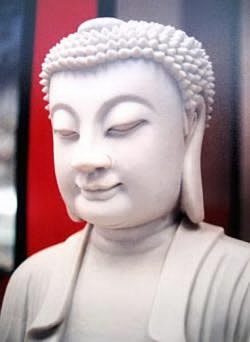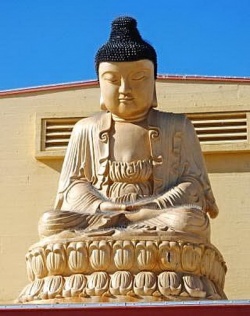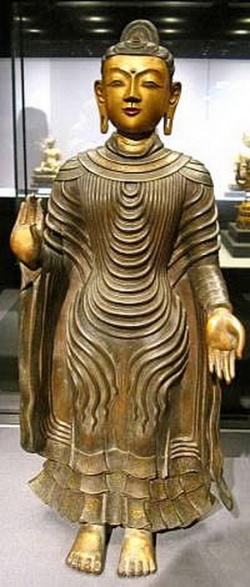Meditation on Emptiness by Lama Zopa Rinpoche
Once again, bring your attention away from hallucination to the realities of Life, the nature of which is impermanence and Death. This frees our mind from Delusion and Karma so that we can not only bring to an end the entire round of Suffering, the cycle of Death and Rebirth, but also eradicate even the subtle errors of mind, thereby attaining Enlightenment for the sake of all Sentient beings. All causative phenomena — our Life, our Body, our mind, our self, our possessions, our relatives and friends, all other people — are changing, not only day by day, minute by minute and second by second, but every tiny moment. They do not last for a fraction of a second. Because they are under the control of causes and conditions, they are in a state of constant decay and can cease at any time. This is the nature of our Life. If we can remain aware of this, we will prevent our mind from coming under the control of the delusions — the disturbing emotional minds that hurt us and other Sentient beings, prevent us from transforming our mind and gaining realizations of the path to Enlightenment, and stop us from seeing the ultimate nature of all phenomena. First we stop delusions from manifesting, and then, by actualizing the remedial path, we eradicate even the imprints that they have left on our mental continuum. By destroying the seeds of Delusion, we attain Nirvana, ultimate liberation from The Six Realms of Suffering and its cause, freedom from the circling aggregates, which are Samsara itself. These are the benefits of Mindfulness of impermanence. We free ourselves of disturbing thoughts, immediately experience peace and satisfaction, free ourselves from Samsara, and eventually attain Enlightenment and enlighten all Sentient beings. Contemplate all this.
Now meditate on Emptiness, the actual nature of all phenomena. Think how your I, actions, objects, and in fact all phenomena — everything that is called "such and such" and "this and that" — are just names. Names have to come from the mind; they don't exist from their own side. Names are labels applied by the mind. However, it is not just that phenomena are labelled by the mind — they are merely labelled by the mind. In other words, all phenomena — I, action, object, everything — are merely labelled by the mind, in relation to their base. Think about this.
How things exist
Now I'm going to elaborate a little on the subject of Emptiness. The way in which everything exists is by being merely labelled by the mind. But that does not mean that everything the mind labels actually exists. Even though everything exists by being merely labelled by the mind, that doesn't mean that if your mind labels something it automatically brings it into existence. For example, say I cut up a huge pile of newspapers into little pieces and my mind labels each one "a billion dollars" — that doesn't make each piece of paper worth a billion dollars. Even though my mind has merely labelled those pieces of paper "a billion dollars," that doesn't mean each one has become a billion dollars. If it were possible for that to happen, we wouldn't have to vote in presidential elections. We wouldn't have to put all that effort into raising funds, campaigning, spending all that money, holding inquiries, to elect the president. All you'd have to do would be to label yourself, "I'm the American president," and you'd become president. If things coming into existence were only up to the mind labelling them, if that's all it took, then that's what would happen. Whenever you wanted to be president, all you'd have to do would be to have your mind label yourself president and you'd be president. In that way, everybody could become president. Maybe there'd be nobody left who wasn't president. A magician could hypnotize you into believing that he'd given you a bag full of money, and you might carry it home, believing you were rich, but later, when you opened it up, there'd be nothing there but cut up pieces of newspaper. That's one way of showing that it doesn't exist — for your own mind to discover that it's not true. Later, when you're not under the influence of hypnosis, you realize that it was an Illusion, that the money you saw didn't exist. Everything was there for your mind — the appearance of money and your mind labelling it money — but it wasn't money. Another way of showing that it does not exist is for other people not to see the money. Because of the Illusion created by hypnosis, money appears to your mind, but other people, whose minds are not under the Illusion, don't see it. Therefore, it takes more than appearance and labelling by mind for something to exist. Dreams are another example of something where your own mind can discover that appearance and labelling by mind are insufficient to bring something into existence. For instance, one night you might have a dream in which you became king, got married in a huge wedding ceremony, lived in a luxurious jewelled palace and had many children. While you are dreaming, the appearance of all this and your mind merely labelling it are both there, but when you wake up you again realize it wasn't true. You're not king, there's no palace, no wealth, no princes and princesses — nothing. You don't have any of that.
A valid base
For things to exist, mere labelling by mind is not enough. There has to be a valid base. Not just any base — a valid base. Therefore, I cannot label my bell "car." This object can receive the label "bell," but not "car" or "airplane." It receives the label "bell' by virtue of the way the valid base functions. Mere labelling by mind is not enough — there has to be a valid base. In the case of a bell, the base has to have a certain shape and perform the function of ringing. This is what validates it. Furthermore, the valid base that is merely labelled "bell" by the mind should not be harmed by another's valid mind. What's a valid mind? A mind that perceives things correctly, that is not under the influence of disease, Drugs, mantras or hypnotic spells, which might cause it to see sense objects in an illusory way. Next, the object we claim to exist should not be harmed by a fully enlightened being's mind. A Buddha's mind is completely unmistaken, completely purified, free from hallucination. All existent phenomena are the object of the omniscient mind; it sees whatever exists. If the omniscient mind does not see the bell, the bell does not exist. Finally, for the bell that is merely labelled by the mind to exist, it should not receive harm from the Wisdom realizing Emptiness, ultimate nature. If the bell, which is merely imputed by the mind, is harmed by the Wisdom realizing Emptiness, it does not exist. Thus, there are three kinds of mind that can harm, or invalidate, the existence of what appears to be, for example, a bell: another person's valid conventional mind; an omniscient mind; and the Wisdom realizing Emptiness. Now, regarding this valid base, this phenomenon that has the function of ringing and possesses this particular shape, our mind creates the label, "bell." This, then, is the real bell, the bell that we use, the one that is merely imputed by our mind, the valid base that is labelled "bell" by our mind.
The worst Ignorance
So what is the bell that does not exist? When our mind perceives the bell, it does not see a bell that is merely labelled by the mind. It sees something slightly beyond that, ever so slightly more than that. It sees something as existing from the side of the bell, something existing from its own side, from the side of the object. If you concentrate, if you analyze carefully how the bell exists, that it is merely labelled by the mind, you can see that there's nothing coming from the side of the bell. When you look deeply into the meaning of "merely labelled by the mind," you can see that nothing exists from the side of the object. When you concentrate on this, you can see how its existence comes only from your mind. But the way the bell appears to us, the way we believe it exists, is slightly beyond its reality, slightly more than its actual mode of existence, which is being merely labelled by the mind. That's where the hallucination begins. Starting from there, the rest of the way it appears is a total hallucination. The way it appears, the way we believe it to exist — as something slightly beyond that which is merely labelled by the mind — is our biggest hallucination, the biggest Suffering in the lives of us Sentient beings. That's what keeps us continually circling in Samsara, dying and being reborn, dying and being reborn, experiencing the same beginningless problems again and again. There's no beginning to our experience of samsaric Suffering and so far it has not ended. Why do we still suffer? Because we have not yet realized Emptiness, the ultimate nature of phenomena — that things are empty, that things exist merely in name. We have not discovered reality; we have not discovered the Wisdom that cuts the root of all Delusion and Karma, the true cause of Suffering, the cause of Samsara. We have not eradicated Ignorance, the unknowing mind. We have continually been creating Ignorance, the root of Samsara. Instead of meditating on Emptiness, practicing Mindfulness, we have been making our mind more and more ignorant. That's why we continue to suffer. So, what is this bell (or any other object you care to look at)? It is nothing other than that which is merely labelled by the mind. But our minds are so replete with negative imprints left by past Ignorance, the simultaneously born concept of inherent existence, that even though things exist as merely labelled by the mind, we hold on to them as if they exist from their own side. We apprehend them as inherently existent, as not merely imputed by the mind. Therefore, this bell is merely labelled by the mind. But because of the negative imprints left on our mental continuum by past Ignorance, the concept of inherent existence, the apprehension and belief that phenomena exist from their own side, as soon as our mind creates the label "bell," as soon as it merely imputes "bell" on the base, the negative imprints left on our mental continuum project the hallucination that it exists from its own side. It's like when you take a roll of film to be developed — the images from the negative are projected onto special paper, mixed with chemicals, and a picture appears to make the photograph — or like putting a film into a projector and beaming the images it contains onto a screen. Whatever the object — a bell, your I — the moment it's labelled by the mind, the negative imprints project upon it the adornment of inherent existence. The thing is that we're unaware, or we forget, that what we're seeing is merely imputed by our mind. Basically, there are three things in the Evolution of all this. First of all, as a start, our mind merely labels the object. Second, the negative imprints left by previous concepts of inherent existence project the appearance of inherent existence that the object we're looking at now exists from its own side, that there's a real bell there — not a bell from our mind, but a bell from the side of the bell. This is a totally, totally wrong idea — a complete hallucination projected onto the bell. Third, we allow our mind to believe that this is one hundred percent true. We allow our mind to hold on to this, to grasp this, as completely, one hundred percent true — that there's a real bell over there, that that's the reality. This is Ignorance. At that moment, we are making our mind ignorant, unknowing. We are making our mind ignorant as to the actual nature of the bell, which in reality is totally empty from its own side. What exists is merely labelled by the mind. The bell, which is totally empty from its own side, exists merely in name. Being unaware of this is an example of how we make our mind ignorant.
Just as this applies to the example of the bell, so is it true for all other phenomena. Starting from our I, the way we see ourselves, everything we perceive is as hallucinated as our view of the bell. Our view is completely wrong and so too is the belief that we hold on to. Starting with the subject, I, whatever we perceive in the course of a twenty-four hour day does not exist the way in which we believe. Think of everything we see during the course of one day; all the objects of form with which our eye sense comes into contact — shapes and colors, billions and billions of things wherever we look. No matter which of these billions of objects we observe, we see each one in just the same way as I described our view of the bell. Just as we don't see the bell as merely labelled by the mind, similarly, we don't see anything else we look at in its true nature, as merely labelled by the mind and totally empty from its own side. Even though, were we to analyze the bell's mode of existence logically, scientifically, we would understand the way in which it exists, that's not how we see it. The bell we see is something else altogether. In the same way, we misperceive every other object of form that appears to our eye consciousness. When we go into a supermarket or department store where even one section contains thousands of objects, we don't see even one of them in the way it exists. We're in a totally different world from the one that actually exists; our world is something else completely. What we see does not exist in the supermarket or the department store. In reality, what we see exists nowhere. Everything we see is cloaked in hallucination. We go into a store and our mind labels things "this, this, this, this, this," but a layer of inherent existence completely covers all these objects merely labelled by mind. To us they appear as not merely labelled by mind, as existing from their own side — an appearance that is totally non-existent, a complete hallucination. This hallucination encases the entire world of form, a world that exists merely in name. It's the same with sound. Before I was talking about forms, visual objects of the sense of eye. But we perceive much more than that. We have four other senses — hearing, smell, taste and touch. Thus, sounds also exist merely in name and not from their own side. But again, we hallucinate with every sound we hear, believing it to be inherently existent, when it's exactly the opposite. Every object of every sense exists merely in name, as a valid base merely labelled by the mind. But as long as we don't develop the Wisdom realizing Emptiness, we'll never see sense objects in their nature, the way they exist. Instead, we cloak these merely labelled sense objects in the hallucination of existence from their own side and hang to that as true, allow our mind to believe in our own hallucination that there really is something there. Because we do not practice Mindfulness meditation on Emptiness, or Dependent arising — Mindfulness on the hallucination that it is a hallucination — we constantly make our mind more and more ignorant. For example, when we dreaming, we can practice Mindfulness that this is but a dream. Similarly, during the day, we can practice Mindfulness that what we're seeing is but a hallucination. If we do this, we're not meditating on something that exists as a hallucination — we're meditating that a hallucination is a hallucination. As a result, what comes into our Heart is an understanding of Emptiness, the ultimate nature of the circle of three — I, action and object. By doing this, we stop making our mind increasingly ignorant. We stop constantly creating the basis for emotional thoughts, delusions, attachment — those unnecessary minds that bring no benefit, only harm, and motivate Karma that becomes the cause of Samsara and all its realms of Suffering.
What is the mind? What's true for the physical senses, as above, is also true for the mind, the perceiver, itself. The mind is a phenomenon too. What is the mind? It is a phenomenon that is not Body, not substantial, has no form, no shape, no color, but, like a mirror, can clearly reflect objects. Objects appear to the mind and the mind can perceive these objects. As long as a mirror is not dirty, it will reflect whatever object comes before it clearly. Similarly, since the mind is unobstructed by substance, form, objects can appear to it. The phenomenon that is mind perceives objects. So, that is the base. In relation to that phenomenon, our thought creates, merely imputes, the label "mind," and that's how the mind exists. The mind also exists merely in name; what we call mind has been merely labelled by thought. It's like when a person is given a name. Mine is Zopa. Actually, it's Thubten Zopa, and it was given to me by my abbot. According to tradition, when an abbot ordains new monks, he gives them his first name. My abbot's first name was Thubten, and then he added the Zopa. With his mind, he labelled me "Zopa." You received your name in a similar way. Whether you named yourself or it was given to you by your parents, your name is a mind-created label. In the same way, then, what's called mind is also a name. We think there's a real mind — a real mind existing from there. That's how it appears to us and, without a shadow of Doubt, we believe one hundred percent in this appearance. But if we analyze this phenomenon called mind, it's no different from the name given to you by your parents, which was created by their mind. What you call mind has been merely labelled by your thought in relation to its base, that formless phenomenon that has neither shape nor color, whose nature is clear and that has the ability to perceive objects. That is the base and "mind" is the label. They're two distinct phenomena, not one. They're not separate, but they're different. That's what we have to realize — that these two phenomena are different. This is what we have to discover through meditation. By doing this we can begin to free ourselves from the hallucination that is the root of all Suffering. This is how we start to liberate ourselves from Samsara.
Schools of Buddhist Philosophy and the object of refutation
I started this discussion by saying how everything exists as merely labelled by mind, and then went on to clarify that simply labelling things is not enough to bring them into existence, that just because something is merely labelled, it exists. Then I went on to mention the three things required for something to exist: a valid base, not receiving harm from another's valid mind, and not receiving harm from the Wisdom realizing Emptiness. Now, going back to the bell. As I mentioned before, the way the bell appears to us and the way in which we believe it to exist are slightly beyond the way it actually exists, which is in mere name, as merely labelled by the mind. This difference is a very subtle hallucination that, in Buddhist philosophical teachings, is called the "object to be refuted," or the "object of refutation." There are four schools of Buddhist Philosophy — Vaibashika (che-tra-mra-wa), Sautrantika (do-de-pa), Cittamatra (sem-tsam) and Madhyamika (u-ma-pa). The fourth of these is the Middle Way school and is divided into two: Svatantrika (rang-gyu-pa) and Prasangika (thal-gyur-wa). According to the Prasangika school, the object of refutation (or negation, gag-cha) is an extremely subtle object that is ever so slightly more than — a little over and above — what is merely labelled by the mind. The object of refutation is what appears to us; it is that in which we believe. In order to attain liberation from the entire round of Suffering and its cause, we need to cut its very root, the fundamental Ignorance that keeps us in it. Of the many kinds of Ignorance, which is the specific one that we have to eradicate? It is not the concept that believes the bell to exist the way it appears, which is what the texts usually describe as the root of Samsara — except that in the case of the root of Samsara, we should be talking about the I, not the bell that I've been using as an example here. When the I appears to us, we believe that there is something slightly over and above what is merely labelled by the mind and that this is how the I exists. Then we believe that this is one hundred percent true and let our mind hold on to that. It is this specific, particular Ignorance that is the root of all Delusion, Karma and Suffering. This very one. It's not just any type of Ignorance — it's this one. As well as this kind of Ignorance, there's the one described by the second Madhyamika school, the Svatantrika — the hallucination on the I, the object to be refuted according to their view. I'm just mentioning this so that you'll have an idea of how trapped our minds are, how many different levels of Ignorance we experience, how many kinds of hallucination there are. The hallucination on the I that the Svatantrikas describe is grosser than the one the Prasangikas explain. Then there's the Cittamatrins' version, where they say that the I exists from its own side without depending on mental imprints, without the mind as creator. They describe a seventh level of consciousness — normally we talk about just six — that is called the basis of Samsara and Nirvana.
So they say that the I exists totally from its own side without depending on imprints left on this seventh level of consciousness and describe it as a self-entity. According to Hindu philosophy, the I, which they call Atman, is permanent. While the self is actually impermanent, they believe it to be permanent. Therefore, there's a lot of discussion in Buddhist texts refuting this view, explaining that while the self may appear to us to be permanent, in fact it changes moment by moment due to causes and conditions and is therefore impermanent. If you look at your I right now, you'll see that it appears to be permanent, whereas you know that in reality it is impermanent in nature. Other views hold, for example, that while the I is dependent upon parts, there is the appearance and the belief that it exists alone, not dependent upon parts, or that while the I is dependent upon causes and conditions, there is the appearance and the belief that it exists with its own freedom, without depending on causes and conditions. These gross hallucinations are described and posited as the object of refutation by the first Buddhist school, the Vaibashika. This school has eighteen divisions, each with its own variant view. Then there's the hallucination that even though the I exists dependent upon the group and continuity of the aggregates, it appears to us as a self-entity existing without depending on the group and continuity of the aggregates. So these are some of the positions held by the Vaibashika and the Sautrantika, the lower Buddhist schools. How has it come about that there are these four schools of Buddhist Philosophy? It's due to the different ways of explaining what the I is. In reality, Emptiness is just one, not many. There is only one Emptiness that directly cuts the root of Samsara. This is the Emptiness taught by the Prasangika-Madhyamika school, whose view of Emptiness is the unmistaken, pure one and the only one that can cut the specific Ignorance that I mentioned before. However, not everybody has the Karma to accept this, to understand this, to realize this. Sentient beings have different levels of mind. Therefore, the all-knowing, kind, compassionate Buddha taught varying levels of philosophy to guide Sentient beings' minds gradually up to the level where they could realize the Prasangika view of Emptiness. One could start with the gross explanations of Emptiness taught by the lower schools and gradually progress up to the most subtle, the Prasangika. That's how the four schools came into being. The lower schools were steps to the higher ones, leading ultimately to the Prasangika. So even though the views of these various schools seem to contradict each other, actually they're a method for gradually developing through study and meditation the Prasangika view.
In case you are interested in practicing meditation on Emptiness, I'm going to explain a couple of simple but quite helpful techniques for doing so. The first technique is one that I often mention during meditation courses — walking meditation on Emptiness. This is a kind of Mindfulness meditation but it's much more profound than the usual Mindfulness of walking where you simply maintain awareness of "I'm walking" and so forth. If you can practice that kind of Mindfulness of walking — "I'm walking" — you can also practice Mindfulness of stealing while robbing a bank or picking somebody's pocket — "I'm stealing." Actually, if you are stealing, it's probably not such a bad idea to be mindful — otherwise you might get caught! Mindfulness meditation should be more than just watching what you are doing. What you really need to watch is your motivation. If you don't watch your mind, you don't know what's motivating your actions. What you should be doing is detecting negative motivation, the cause of Suffering, and changing it into positive. You should be applying your meditation like a medicine to the eradication of harmful thoughts, the delusions — the disturbing emotions that harm yourself and others. You need to eradicate these and make your mind healthy and your attitude beneficial, just as The Buddha explained in the verse I quoted before:
Do not engage in any harmful actions;
Perform only those that are good....
Abandon non-virtue, the cause of Suffering, and practice virtue, the cause of Happiness. Transform negative motivation into positive so that your actions will become virtuous. In this way you will not waste your Life but make it meaningful. At least you won't be harming yourself or others. The way to practice more meaningful Mindfulness is this. For example, when you're sitting or when you're walking, ask yourself the question, "What am I doing?" Then your mind will answer, "I'm sitting," "I'm walking," "I'm eating," depending on what it is that you're doing. "I'm cooking," "I'm talking." Whatever you are doing, you can meditate on Emptiness. One way in which you can do this is to reply to the answer "I'm walking" with another question: "Why do I say 'I'm walking'?" Then you analyze; you look for the reason. What you find is, "The only reason I say this is that my aggregate of Body, the base I label "I," is walking." Your Body is walking — just because of that, your mind labels and believes "I'm walking." After you've done that, check how your I appears to you at that moment. Is it the same as before or has there been a change? Usually you'll find that it's not the same, that there's been a definite change. Suddenly, the old view of a real I in your Body, appearing from that side, the I you have always believed to be there in your Body, has vanished, become non-existent. And that's the truth. It's not a false view. The old I was the false one. When you do not meditate, do not analyze, the I that appears to you and in which you believe — the I that seems to be on these aggregates, in this Body — is the false one. In philosophical texts, we refer to that I as inherently existent or existing by nature. In Western psychological terms, we call it the "emotional I." The emotional I — the one that you believe is in your Body or on your aggregates — is totally non-existent. That is what you have to discover — that it's empty. You have to discover that it is totally non-existent, totally empty. If you can realize that — that there's not even the slightest atom of an I there — and feel as if you yourself have become totally non-existent, you have entered the Middle Way. At that time, when you realize Emptiness, you gain full conviction, or definite understanding, that you can attain liberation, you can cease all Suffering and its cause. Remain in the state of your discovery of the absence of the emotional I. Keep your mind in the Emptiness of that. When your mind gets distracted, again ask yourself the question, "What am I doing?" Then, when your mind replies, ask again, "Why do I say 'I'm doing... '? There's no reason other than...," whatever it is. If the answer is, "I'm meditating," ask yourself, "Why do I say 'I'm meditating'?" There's no reason other than the fact that the base, the aggregates of mind, are transforming into virtue (which is what meditation really means). Then check again to see what effect this has had on your I. Has there been a change or not? Doing this meditation again and again helps you see the false I more and more clearly. The more clearly you see the false I, the emotional I, the I that doesn't exist, the more clearly you see, the better you recognize, Emptiness — the better idea of Emptiness you get. The second technique for meditating on Emptiness is one that takes you back to your childhood, to the time before you had learned the alphabet. Imagine yourself before you knew your ABCs. You're sitting in the classroom and your teacher draws a letter on the blackboard for the first time. You, the child, have no idea what it is, what those lines represent. Although the teacher draws an A, you have no appearance of A. Even though you see the lines on the blackboard, A does not appear to you. You see the lines but you don't see them as A. That's because your mind hasn't labelled those lines as A and believed in that. Remember, labelling is not enough — in order for there to be appearance, you have to believe in it as well. At this point in your Life, your mind has not yet labelled that configuration and believed, "This is an A." Then your teacher tells you, "This is an A," and your mind — believing what your teacher has said, in relation to that base, those lines on the blackboard — creates the label A, merely imputes it on the base, and believes in it. Only then do you have the appearance of the letter A. After that, then you see that this is an A. The point to understand here is that first there's that arrangement of lines, which is the base.
What is it that makes your mind decide upon the particular label A? You don't label any old configuration A — it has to be this particular pattern. That's why your mind chooses to label it A — it sees the appropriate pattern. That is the base; the base to be labelled A. So you can see that the base, that particular pattern, and the label are different. This is the point I'm trying to make. The pattern is the base and the A is the label. These are two different phenomena, not one. They appear as one — without analysis, to your mind they appear as one. It looks as if the A is on top of the base, that pattern. It looks like that. If you do not analyze, it appears as if the A were right there, on that pattern, as if the A were there on that base. So, the pattern is the base and the A is the label. Now you need to concentrate on the conclusion. Before your mind creates the label A, you see the base, that particular pattern, first. That's what causes you to apply the label A. From this it's clear that the base is not the A. If it were, you should see the A at the very first moment you saw the base, but that isn't what happens. It doesn't happen no matter what phenomenon you see. First you see the base; then you apply the label. Your mind creates the label after seeing the base. Taking a pillar, for example — the specific base that holds things up, that performs that particular function — seeing that base first causes your mind to choose the label "pillar." Then you see the pillar. You don't see it from the very beginning. If you saw the base but your mind didn't label it, you wouldn't see the pillar. Similarly, you see the A later. That means that the pattern and the A are not one. The pattern is not A — it is the base to be labelled A. This is the point to understand. The difference between the two. This is one line of reasoning. A second line of reasoning goes as follows. Look for the A. On that pattern, where is the A? Look at the upstroke (/). You don't find the A there. Look at the downstroke (\). It's not there either. Nor is the A on the crossbar (-). Even when the three lines are assembled into the configuration A, that's not the A because that's the base to be labelled. Only after seeing it do you label it A. So the three lines together are not the A either. So when you see that three-line pattern on a blackboard, there's no A on the pattern, but there's an A on the blackboard, and the only reason you can say that is that the pattern is on the blackboard. Similarly, when you look out your window and see a car go by, analyze what happens. First of all, before anything appears, you don't label "car" because you haven't seen anything. There's no reason for you to label, "There goes a car." When a car does go by, you don't label it "car" the very moment you see it because for your mind to choose that particular label, "car," you have to see something first, as we've been saying. What causes your mind to create the label? There has to be a prior reason. You have to see something before you create the label. What you see is the base — the phenomenon that has the appropriate shape and performs the function of going here and there, transporting people and so forth — you have to see that first. The label "car" comes after that. First you see the base; then you see the car. You see the car after you have applied the label. Therefore, it is a hallucination. Whatever you see go by — a person, a cat, a dog, a motorcycle — it works the same way. Under normal circumstances, when we do not analyze what we see, when a car goes by it looks as if either the base itself is the car or there's a car on that base, and that that's what's going by. This is a complete hallucination. There's no car there, just as there's no A on that configuration of three lines.
The car exists but it's not there. It's the same thing with the A. When we look at the A and do not analyze, do not meditate, it looks as if the A is there, on that pattern. That too is a complete hallucination. That is the object to be refuted — the A that is there not merely imputed by the mind. An A that if you look for it can be found. That's the object of refutation; that's what we have to realize is empty. And that Emptiness is the ultimate nature of the A. The reason that seeing an A on the base is a false view is that if you try to find precisely where on each of the three lines it is (/\-), you can't find it. And when you look for it on the three lines assembled (A), you can't find it there either. Each piece is not A. Nor is the assembled pattern, because that is the base to be labelled A. By analyzing in this way, you can recognize your everyday hallucinations, your false view, and understand what you have to realize as empty. What Emptiness means. Analysis makes it clear. Practicing Mindfulness of this, meditating on this, helps you to control your emotional mind. It becomes almost impossible for emotional thoughts, such as attachment and Anger, to arise. That means you stop motivating Karma, the cause of Samsara, the cause of the lower realms. Thus it becomes incredible protection, a great source of Happiness and peace, and the cause of liberation and Enlightenment for yourself and all other Sentient beings. By developing this Wisdom and practicing Bodhicitta, you yourself can attain Enlightenment and lead all other Sentient beings to Enlightenment as well. Therefore, if you really want to practice Dharma, meditate, and see some development in your Life, if you want to clarify and deepen your understanding of Emptiness and bring yourself closer to realizing it, these techniques might help, even though they don't utilize philosophical concepts, the four-point analysis and so forth. By practicing these techniques, you can see more clearly how the mind is not I, which is what many people think. Many things become clear.






